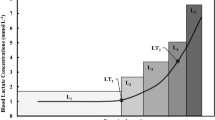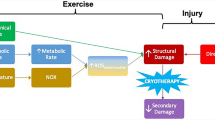Abstract
This study examined heat stress, heart rate (HR), fluid balance, micro-environment temperature and humidity with Islamic athletic clothing (IC) compared to traditional soccer uniform (SC). Ratings of perceived exertion (RPE), session RPE (S-RPE), comfort, and cooling response were also examined. Female volunteers (N = 8) completed a treadmill \( \dot{V}{\text{O}}_{{2{\text{peak}}}} \) test and then, in a randomized, counter-balanced order, two intermittent running bouts (45 min total) in a hot environment (30.0°C WBGT) in IC and SC. Thereafter, participants sat for 40 min in the hot ambient environment. Repeated measures ANOVA revealed significantly greater micro-environment temperature (p = 0.02) (IC 33.3 ± 3.2°C, SC 32.0 ± 2.8°C) and humidity (p = 0.04) (IC 48.4 ± 8.1%, SC 42.9 ± 7.9%) in IC during the exercise trial but no difference in the 40-min recovery period for micro-environment temperature (p = 0.25) or humidity (p = 0.18). No significant difference (p > 0.05) was shown for core temperature (T rec) (IC 38.3 ± 0.4°C, SC 38.2 ± 0.4°C), HR (IC l54 ± 28 beats min−1, SC 151 ± 26 beats min−1) or RPE (IC 4.7 ± 2.1, SC 3.8 ± 1.7) during the exercise trial or recovery period. Results from a paired t test revealed a significantly greater (p < 0.05) S-RPE (IC 5.8 ± 1.2, SC 4.3 ± 1.9), sweat loss (IC 1.4 ± 0.4 L h−1, SC 1.2 ± 0.4 L h−1) and greater discomfort during the exercise and recovery period for the IC. IC clothing appears to have no detrimental effects on heat storage or heat strain during exercise or recovery.









Similar content being viewed by others
References
Bangsbo J, Nørregaard L, Thorsøe F (1991) Activity profile of competition soccer. Can J Sports Sci 16:110–116
Bishop PA, Gu DL, Clapp A (2000) Climate under impermeable protective clothing. Int J Ind Ergon 25:233–238
Broad EM, Burke LM, Cox GR, Heeley P, Riley M (1996) Body weight changes and voluntary fluid intakes during training and competition sessions in team sports. Int J Sports Nutr 6:307–320
Demello JK, Cureton J, Robin J, Boineau E (1987) Ratings of perceived exertion at lactate threshold in trained and untrained men and women. Med Sci Sports Exerc 19:354–362
Drust B, Reilly T, Cable NT (2000) Physiological response to laboratory based soccer specific intermittent and continuous exercise. J Sports Sci 18:885–892
Fanger PO (1970) Thermal comfort. Danish Technical Press, Copenhagen, pp 12–32
Goldman RF (1963) Tolerance time for work in the heat when wearing CBR protective clothing. Mil Med 128:776–786
Green JM, Yang Z, Laurent CM, Davis JK, Kerr K, Pritchett RC, Bishop PA (2007) Session RPE following interval and constant resistance cycling in hot and cool environments. Med Sci Sports Exerc 11:2051–2057
Ha M, Tokura H (1995) Effects of two kinds of clothing made from hydrophobic and hydrophilic fabrics on local sweating rates at an ambient temperature of 37°C. Ergonomics 7:1445–1455
Ha M, Tokura M, Yanai Y, Moriyama T, Tsuchiya N (1999) Combined effects of fabric air permeability and moisture absorption on clothing microclimate and subjective sensation during intermittent exercise at 27°C. Ergonomics 7:964–979
Henane R, Bittel J, Viret R, Morino S (1979) Thermal strain resulting from protective clothing of an armored vehicle crew in warm conditions. Aviat Space Environ Med 50:599–603
Huffman EA, Yard EE, Fields SK, Collins CL, Comstock D (2008) Epidemiology of rare injuries and conditions among United States high school athletes during 2005–2006 and 2006–2007 school years. J Athl Train 43:624–630
Jetté M, Quenneville J, Thoden J, Livingstone S (1995) Reproducibility of body temperature response to standardized test conditions when assessing clothing. Ergonomics 38:1057–1066
Kirkendall OT (1993) Effects of nutrition on performance in soccer. Med Sci Sports Exerc 25:1370–1374
Kwon A, Masko K, Kawamura H, Yanai Y, Tokura H (1998) Physiological significance of hydrophilic and hydrophic textile materials during intermittent exercise in humans under the influence of warm ambient temperature with and without wind. Eur J Appl Phys 78:487–493
Maughan RJ, Leiper LB (1994) Fluid replacement requirements in soccer. J Sports Sci 12:29–34
Mihal CP (1981) Effect of heat stress on physiological factors for industrial workers performing routine work and wearing impermeable vapor-barrier clothing. Am Ind Hyg Assoc J 42:97–103
Millevic PM (1981) Sensory cues for perceived exertion: a review. Med Sci Sports Exerc 13:150–163
Mohr M, Krustrup P, Bangsbo J (2003) Match performance of high-standard soccer players with special reference to development of fatigue. J Sports Sci 21:439–449
Mohr M, Krustrup P, Andersson H, Kirkendal D, Bangsbo J (2008) Match activities of elite soccer women players at different performance levels. JSCR 22:341–349
Noble JG, Borg G, Jacobs I, Ceci R, Kaiser P (1983) A category-ratio perceived exertion scale: relationship to blood and muscle lactates and heart rate. Med Sci Sports Exerc 15:523–529
Pollock ML, Schimidt DH, Jackson AS (1980) Measurement of cardiorespiratory fitness and body composition in the clinical setting. Clin Ther 6:12–27
Robertson RJ (1982) Central signals of perceived exertion during exercise. Med Sci Sports Exerc 14:390–396
Robertson RJ, Noble BJ (1997) Perception of physical exertion: methods, mediators, and applications. Exerc Sports Sci Rev 32:407–452
Robertson RJ, Goss FL, Dube J, Ruthkowski J, Dupain M, Brennan C, Andreacci J (2004) Validation of the adult OMNI scale of perceived exertion for cycle ergometer exercise. Med Sci Sports Exerc 36:102–108
Shirreffs SM, Maughan RJ, Vargas LF, Chamorro M, Serratosa L, Zachwieja JJ (2005) The sweating response of elite professional soccer players to training in the heat. Int J Sports Med 26:90–95
Speckman KL, Allan AE, Sawka MN, Young AJ, Muza SR, Pandolf KB (1988) Perspectives in microclimate cooling involving protective clothing in hot environments. Int J Ind Ergon 3:121–147
Stoudemire NM, Wideman L, Pass KA, McGinnes CL, Gaesser GA, Weltman A (1996) The validity of regulating blood lactate concentration during running by ratings of perceived exertion. Med Sci Sports Exerc 28:490–495
Utter AC, Robertson RJ, Green JM, Suminski RR, McAnulty SR, Nieman DC (2004) Validation of the Adult OMNI Scale of perceived exertion for walking/running exercise. Med Sci Sports Exerc 36:1776–17780
Williams J, Wilkins P (2006) American College of Sports Medicine. Guidelines for exercise testing and prescription, 6th edn. Philadelphia, PA
Author information
Authors and Affiliations
Corresponding author
Additional information
Communicated by George Havenith.
Rights and permissions
About this article
Cite this article
Davis, JK., Bishop, P.A., Zhang, Y. et al. Fluid balance, thermal stress, and post exercise response in women’s Islamic athletic clothing. Eur J Appl Physiol 112, 725–734 (2012). https://doi.org/10.1007/s00421-011-2026-9
Received:
Accepted:
Published:
Issue Date:
DOI: https://doi.org/10.1007/s00421-011-2026-9




